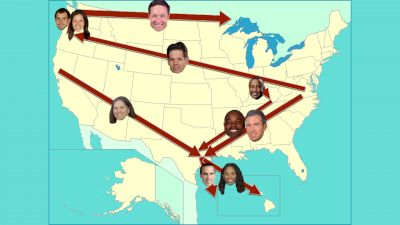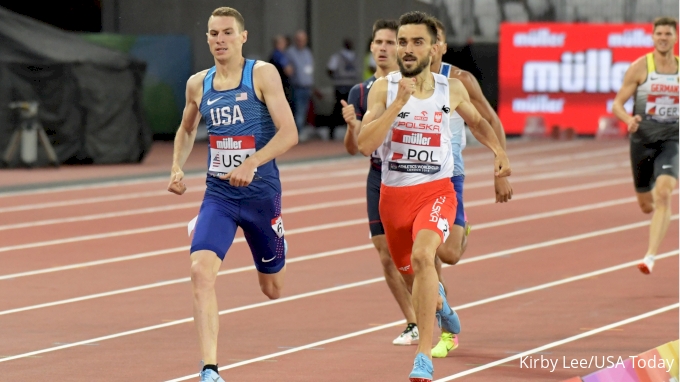How Can The Athletics World Cup Be Improved?
How Can The Athletics World Cup Be Improved?
The Athletics World Cup was overshadowed by bigger meets on the track and field calendar this year. Is there a future for the team-based competition?

For the United States, the Athletics World Cup this past weekend in London was a success.
The American squad won the eight-team competition and, let’s be honest, it was nice just to be included in an event this year that had the words “World Cup” in the title.
But as a whole, the event struggled. Like most meets in this off-year, it failed to turn out the big names. And with the constraints of limiting the competition to only eight teams (U.S., Poland, Great Britain, Jamaica, France, Germany, South Africa, and China) many of the fields didn’t offer much depth.
The inherent appeal of team competition is that it overrides the reliance on the specific participation of individuals. But because track (and especially professional track) is fiercely individual, that appeal is tested. Ask yourself: Would a track and field fan care more about a meet with no big names and team scoring, or one that features a few events with the world’s best?
The latter exists in the form of Diamond League (and virtually every other meet on the calendar). The question is, will a track fan support the team-style setting from this past weekend moving forward? But before they dump it (or declare it an unmitigated success) they should try to make these adjustments to the next edition of the World Cup.
Choose A Better Date
Other than staging the meet during the U.S. Championships, organizers couldn’t have selected a less opportune time to have the meet. There were the obvious scheduling conflicts in the track and field world with the overlapping of the U20 Championships and the Diamond League meet in Rabat. Outside of the track world, the meet also matched-up against Wimbledon and the final two matches of the World Cup. Advantage: not track and field.
Breaks in the Diamond League do exist and, where possible, the World Cup should try to slide into those. At the very least, the meet should give itself a chance to attract the top athletes. That’s hard to do when you are preventing them from getting a bigger payday at more lucrative meets.
Ensure The Best Athletes Show Up
This is the both the most obvious and hardest solution for the meet. Because of the aforementioned scheduling conflicts, it was difficult to get the best representative from each country in the 34 events that were contested. If the meet was able to pull it off, there could have been some good fields:
Women's 1500m: Laura Muir vs Shelby Houlihan vs Caster Semenya in the women’s 1500m
Men's 100m: Ronnie Baker/Noah Lyles/Christian Coleman vs Jimmy Vicaut vs CJ Ujah/Reece Prescod vs Su Bingtian vs Akani Simbine
But with the eight nations that were selected (and the events that were offered) there are still limitations. The men’s 800m, for example, featured Clayton Murphy and Poland's Adam Kszcot. France’s Pierre-Ambroise Bosse skipped the meet, but other than him, the 800m squeezed the most they could out of the given countries. The problem is that many of the remaining countries don’t have an A-list 800m runner to offer. And if they do, they don’t have the depth to absorb any scratches.

It’s challenging to find eight nations that are good enough to offer compelling fields across 34 events. Even with distance events eliminated, most countries don’t have the breadth of the U.S. in a competition like this. Even if China sends their best, they still don’t have a competitive 800m runner or 400m hurdler. Which brings me to my next suggestion . . .
Modify The Countries That Participate
China didn’t compete in 15 of the 34 events offered. Did they just decide to blow these off? Or did they legitimately not have a body to put on the track? Regardless, it waters down the meet and underscores how hard it is to field eight full teams.
But eight is a good number to have. There are eight lanes on a track. You score the top eight finishers.
If you dropped the number of countries (say from eight to four) to exclude a nation like China then you are relying on teams to increase their own entries per event. If a country doesn’t have one good pole vaulter, then they certainly don’t have two.
Organizers should press to get assurances from all eight nations that they will field a full team.
Don’t have a decent hurdler? As long as they cross the line they get a point.
Nobody in your country has a high jump mark in the top 200? Hey, upsets happen.
Just scratching events and leaving open lanes is a bright red flashing like that screams, "I don’t care . . . this meet isn’t that important . . . you should be watching Wimbledon instead."
Offer Fewer Events
Since it will be difficult to tweak the number of countries, the program could be altered to offer fewer events. Maybe scale it back to just sprints and jumps for a year to see what happens (or throws and sprints—you get my point).
This could have the outcome of more robust participation from each country and field quality could increase. Cutting the number of events can also move the meet from two days down to one, which is plus.
Track and field’s desire to be inclusive is one of its distinguishing features, from grade school meets all the way to the professional level. It yields mixed outcomes and with a competition that is new and inconsequential, it’s worth experimenting to see if there’s a way to find the optimal amount of events.